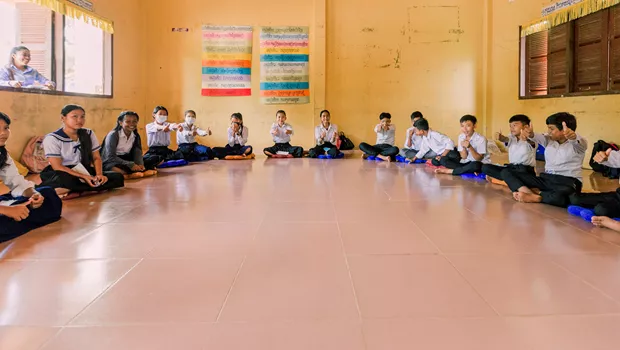As an education-focused organization, we know knowledge is power. That’s why we were excited to share what we’ve learned over the past few years with more than 3,000 attendees of the annual Comparative & International Education Society 2022 Conference, commonly known as CIES. From how to create effective home learning environments to our experience providing virtual teacher trainings, the Room to Read team shared our research and experiences while also learning from other conference presenters and attendees.
Read on to learn about Room to Read staff presentations at the event!
- Creating room to read at home: Building literacy through home libraries
- Developing a love of reading with technology: Reflections from virtual teacher trainings
- Supporting assessment-informed instruction: Lessons from Asia and Africa
- Chain reaction: the challenges and opportunities in Africa’s book ecosystem
Creating room to read at home: Building literacy through home libraries
In response to the global education crisis caused by the COVID-19 pandemic, our team set out to help parents and caregivers build child-friendly home learning environments that would support continued learning during extended school closures. According to a 2008 study in Educational Research & Evaluation, “Home literacy environments and children’s reading performance: A comparative study of 25 countries,” young learners who engage in home literacy activities and have a diverse collection of age-appropriate reading books in the home are more likely to meet key literacy benchmarks in their education. To that end, Room to Read’s literacy team has, over the last two years, equipped households with quality learning materials, including our home library packages, storybooks, instructional guides and educational worksheets — all delivered directly to students’ communities.

In their presentation, “Supporting the home literacy environment: Insights from Southeast Asia,” Patrick Curry and Kerri Thomsen from Room to Read’s literacy team shared their experiences supporting country teams to develop and implement these home library packages in Room to Read partner communities across Cambodia and Laos. To date, Room to Read has distributed more than 1.4 million books to more than 93,000 children across Cambodia, and more than 90,000 books to more than 11,0000 children in Laos. Initial data revealed that 95 percent of families included in the study used the home library packages with their children at least once a week during school closures, that most children frequently read the storybooks independently and that nearly 80 percent of students between Grades 3 and 6 read storybooks aloud to their family members, many of them also sharing their storybooks with friends. Though more research is needed, this extensive sharing may point to an increasingly active reading culture in these communities.
In supporting the home literacy environment, Room to Read has helped to ensure that children and their parents have the educational resources needed to continue learning and developing a love and habit of reading at home — during pandemic-related school closures and long after schools reopen.
Developing a love of reading with technology: Reflections from virtual teacher trainings
Since 2014, Room to Read has partnered with local organizations in Indonesia to develop storybooks, establish libraries and train teachers. In 2019, to increase the number of storybook titles available for library reading activities, we began guiding teachers through the process of accessing books through our digital library, Literacy Cloud. We also discussed the benefit of utilizing a projector during read alouds to give students the opportunity to read along with their teacher or librarian. In total, 760 teachers from Indonesian primary schools were trained by Room to Read and our partner in Indonesia, Provisi Mandiri Pratama, between 2019 and early 2020. Trainings were enhanced by Room to Read-trained literacy coaches, who held sessions with teachers on improving read aloud skills and mastering technological tools that would make it easier to access digital books and other educational resources.
With the onset of the COVID-19 pandemic in early 2020, the team had to pivot their in-person training to a new virtual landscape — and do so quickly to ensure teachers were supported as they too adjusted to a virtual learning environment, one in which technological tools were more important than ever before. In the months that followed, Room to Read and local partner staff worked together with Indonesian government partners to facilitate myriad virtual teacher trainings, webinars and workshops. Two thousand teachers from schools with Room to Read-supported libraries received online training to prepare for virtual reading time with students using Zoom. Nearly 200 teachers received one-on-one coaching to reflect on the complexities of delivering their lessons virtually. More than 1,300 teachers from 110 schools joined regular group workshops addressing common read aloud challenges and pandemic-specific concerns. And more than 5,000 teachers nationwide participated in a series of webinars on capacity building, looking closely at the ways in which educators could conduct fun and engaging reading activities with children, both online and in-person.

In their presentation, “Pivoting to online training and support: Developing a love of reading through technology during a pandemic,” Kerri Thomsen, associate director of Room to Read’s Literacy Program, and Rika Yudani, a member of the ProVisi Mandiri Pratama team, reflected on key takeaways from these teacher trainings, and on the lessons learned in transitioning from in-person coaching to an entirely virtual format. Data collected from regional implementing partners and teachers revealed that, when providing remote training, it was essential to provide quality, engaging content, to have foundational videos available to review key ideas and to use daily Google forms for individual and group reflection. The presentation also stressed the importance of making trainings interactive by bringing educators into conversations with the use of interactive tools, such as quizzes, polls and break-out groups and adding ice breakers or short games to energize participants, all of which helps to cultivate connections and build relationships.
Kerri and Rika also shared encouraging results from a Room to Read-commissioned external evaluation. A survey of teachers active on Literacy Cloud from March 2019 to December 2020 found that 74 percent of teachers trained during Room to Read and ProVisi workshops have since adjusted their practice in the classroom or library due to Literacy Cloud. Of these teachers, 82 percent reported that they now use Literacy Cloud directly with students and 66 percent noted that they have observed positive changes in their students’ enthusiasm for books and mastery of reading skills.
Virtual trainings will continue throughout 2022, with many complemented by in-person support. We will train new partners to establish libraries in additional regions and will continue to offer national webinars while we conduct additional research on the most effective forms of virtual teacher training.
Supporting assessment-informed instruction: Lessons from Asia and Africa
In “Supporting assessment-informed instruction,” Room to Read’s Research, Monitoring & Evaluation team presented two studies on the importance of assessment-informed instruction, which is vital to improve student learning outcomes. Assessment-informed instruction requires that educators:
- Know who in their classroom may be struggling or excelling,
- Know how and why students are struggling or excelling,
- Know what to do about it and
- Have the strategies and resources to respond.

For more than five years, Room to Read has implemented a twice-yearly, classroom-based assessment across nine countries to support teachers in this process. We’ve also recently embarked on a series of studies to learn from this experience and improve our assessment model. Christine Beggs, vice president of Research, Monitoring & Evaluation, presented on Room to Read’s research framework for assessment-informed instruction, emerging best practices and an analysis of how well student assessment data collected by teachers in the classroom predicts students’ scores on more formal assessments.
Emerging findings indicate that implementation of our classroom-based assessments has resulted in:
- Improved ownership and use of data by staff, teachers and administrators
- More focused conversations about learning between coaches, teachers and parents
- More teachers who feel empowered to assess their students and respond to the results
- More explicit understanding of reading building blocks by teachers and administrators
- More follow-up or remedial support for students where the educational system is supportive
The study found a very strong relationship between student scores on classroom-based assessments and student scores on formal early grade reading assessments — indicating that the assessments administered in the classroom by teachers provide a robust signal of student outcomes. This is an important finding as education systems need to find more flexible and efficient methods of assessing student reading outcomes.
The second presentation on assessment-informed instruction was delivered by Maurice Sikenyi and Pinaki Joddar and focused on a pilot of a group-administered written reading assessment. This pilot was conducted in Tanzania to develop of a more realistic and efficient way of assessing students where early grade class sizes often exceed 100 students. The pilot included a comparison of a group written assessment, an individual written assessment and an individual oral assessment. The pilot found that there was significant preparation required for the group written assessment and that the Grade 1 administration took nearly twice as long as the Grade 2 administration given the need to repeat and clarify instructions for the younger students. Grade 1 students also experienced fatigue toward the end of the assessment and that may have adversely affected their scores. The response patterns across the three different assessment designs indicate that students performed better on the group written assessment but were willing to attempt more questions on the individual oral assessment. The Research, Monitoring & Evaluation team is planning for another, larger pilot in Tanzania to improve the process and further test how student scores are influenced by the different assessment designs. We will also be surveying Room to Read staff and teachers to seek their advice about how to improve our model for assessment-informed instruction.
Chain reaction: the challenges and opportunities in Africa’s book ecosystem
And finally, in “Book supply chain in Africa: challenges and opportunities,” Alison Ziki, Room to Read literacy manager in Africa, discussed the many challenges and opportunities that exist in the children’s book ecosystem and supply chain in Africa, and how Room to Read is helping to close gaps in available local-language storybooks.
In his presentation, Alison described an ideal scenario — a book supply chain offering regularly available, accessible, age-appropriate and affordable books in local languages. Children’s storybooks play a critical role in improving quality education and learning outcomes, and access to stimulating local-language book collections is an important determining factor in achieving early literacy and developing a lifelong habit and love of reading. Yet research has confirmed that many historically low- and middle-income countries are a long way from this ideal. Many communities experience a significant under supply of storybooks, particularly in local languages, and that when books are available, there are critical issues in quality and utilization.
Alison’s presentation broke down challenges in the book supply chain in Africa into four primary buckets:
- Demand and financing
- Issues of capacity
- Lack of a culture of reading
- Governance challenges
Many African countries, Alison noted, do not spend enough on textbooks or reading books and lack the capacity to increase spending. Publishers often can’t invest in writers, illustrators, editors or book designers, and creative professionals often lack necessary training, materials and access to financial support. Moreover, ineffective book distribution systems often result in loss of inventory, book damage and delivery delays. Many countries also lack a strong culture of reading. In South Africa, for example, 58 percent of adults live in households with no books at all, and only 15 percent of the population reads for pleasure, according to the South African Book Development Council.

Despite these challenges, there are opportunities. In his presentation, Alison discussed some of the innovations that Room to Read and other stakeholders in the children’s book ecosystem in Africa have explored in an effort to strengthen local book supply chains. For starters, in recent years Room to Read has experimented with what’s called results-based financing (RBF), a model that finances a project after agreed-upon results have been achieved. The approach has the potential to provide a stronger focus on the actions necessary to improve learning outcomes, foster local solutions to common education challenges and strengthen the capacity of the local book chain to operate more effectively. As part of his research, Alison paid particular attention to the case study of the World Bank-funded REACH project in South Africa (2017–2019) and the innovations that accompanied the project, which included open or free book licensing, the Book Dash model, which harnesses professional creative volunteers to vastly reduce the time and costs involved in creating beautiful open-licensed books for children, pooled procurement for greater book purchasing power and other potential solutions.
We have also cultivated partnerships with local publishers and book creators to co-create and co-publish new children’s book collections in local languages and have partnered with ministries of education to strengthen the book publishing ecosystems in Tanzania, South Africa, Uganda and Rwanda. In fact, this past January Room to Read partnered with the Reading Association of Uganda, a local chapter of the International Literacy Association, to host our first ever in-person Writers’ and Illustrators’ Workshop in the country. In the coming months, six of the participating illustrators will create artwork for 11 Room to Read original storybook titles that will be published in Luganda, the primary language of instruction across the country, and Ruyankore-Rukiga, a common language of instruction in southwestern Uganda.



